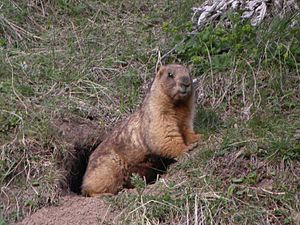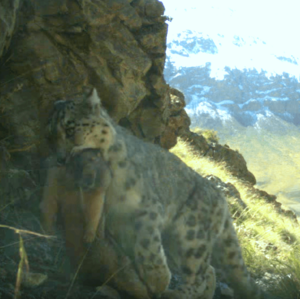Gray marmot facts for kids
Quick facts for kids Gray marmot |
|
|---|---|
 |
|
| Conservation status | |
| Scientific classification | |
| Genus: |
Marmota
|
| Species: |
baibacina
|
The gray marmot, also called the Altai marmot, is a type of rodent. It belongs to the squirrel family. This marmot is one of the larger kinds of marmots.
You can find gray marmots in the mountains and grasslands of central Asia. They live in places like Xinjiang Province in China, southeastern Kazakhstan, Kyrgyzstan, Mongolia, and parts of Siberia in Russia. In some areas, their home overlaps with another marmot called the Tarbagan marmot. Gray marmots are social animals. They live in groups, dig burrows, and sleep through the winter.
Contents
What They Look Like
Gray marmots are big! They usually weigh about 4 to 6.5 kilograms (9 to 14 pounds). Some can even reach nearly 8 kilograms (18 pounds) before they hibernate. Their size can change depending on the time of year. They lose a lot of weight during their long winter sleep.
These marmots are short and strong. They have powerful legs and short tails. Their total body length is about 60 to 80 centimeters (24 to 31 inches). This includes their tail, which is about 13 to 15 centimeters (5 to 6 inches) long. Their front paws have four toes with strong claws for digging. Their back paws have five toes.
Their fur on their back is beige to tan. It has brown or black tips, which makes them look gray. Their belly is more of an orange-reddish brown. Their tail is dark brown to black at the tip. They have small, round, light-colored ears. Their face is darker brown on the cheeks and lighter around the mouth. Sometimes, gray marmots can be albino (all white). It's hard to tell males and females apart just by looking at them.
Where They Live
Gray marmots live in mountain meadows and steppes. They eat sage bush in spring. In summer and fall, they munch on grasses and flowering plants. They can be found at different heights, from 150 to 4000 meters (about 500 to 13,000 feet) high. They like slopes that drain water well and have good soil for digging.
Their home stretches from the Altai mountains in Siberia to the Tien Shan mountains. This includes parts of western Mongolia, northwestern China, Kyrgyzstan, and eastern Kazakhstan. In some areas, their range goes into lower, drier grasslands. Gray marmots were also brought to the Caucasus mountains in Russia.
In western Mongolia, gray marmots share their home with Tarbagan marmots. When they live in the same area, gray marmots tend to stay higher up in the mountains. They prefer places with scattered rocks. It's rare to see these two marmot types mixing or having babies together.
Ancient Discoveries
Scientists have found fossils of gray marmots in Denisova Cave. This cave is famous because it's where the first remains of ancient humans called Denisovans were found.
Life and Habits
Social Life
Gray marmots are very social animals. They live in groups called "extended families." Many individuals live together in one burrow. Several burrows close together form a "colony." An extended family usually has a main adult male and female. They also live with a few other adults, yearlings (one-year-olds), and babies.
Gray marmots have special alarm calls. These calls help them warn their family about danger. Each type of marmot has its own unique call. This helps scientists tell them apart. When times are tough, like when there's not much food, families might be smaller. When conditions are good, families can grow larger and more complex.
Hibernation
Gray marmots live in places with a lot of snow. This means food is hard to find for a long time. So, they have a special yearly cycle. They hibernate, then reproduce, grow, and then eat a lot to get fat for the next hibernation.
Gray marmots hibernate for 7 to 8 months. They start in the fall and come out in May. When they start hibernating depends on where they live. Marmots in lower areas or on sunny slopes wake up earlier.
Burrows
Gray marmots dig amazing burrows. Their winter burrows, where they hibernate, can be 5 to 7 meters (16 to 23 feet) deep. Some tunnels can be as long as 63 meters (207 feet)! These winter burrows can hold 10 or more marmots. Living together helps them stay warm and save energy. Their summer burrows are not as deep and usually hold only a few marmots.
Reproduction and Life Cycle
Gray marmots mate in early May. They often mate in their burrows even before they come out of hibernation. A female marmot is pregnant for about 40 days. She usually gives birth to 2 to 6 babies. Females can start having babies when they are 2 to 3 years old. They often have babies every other year. If conditions are very harsh, females might not have babies that year.
Predators

Many animals hunt gray marmots. These include wolves, foxes, dogs, polecats, and Pallas's cats. Birds like hawks and falcons also hunt them. Gray marmots use their alarm calls to warn their family when a predator is nearby.
Communication
Gray marmots use different ways to talk to each other. They have special glands on their cheeks and near their tail. These glands might help them show who is in charge or even for defense. They also use their tails to send visual messages. And they make different sounds like growls, high-pitched cries, whines, and alarm calls.
Family Tree
The gray marmot is a type of marmot found in Eurasia. It is closely related to the forest-steppe marmot. Until recently, the forest-steppe marmot was thought to be a subspecies of the gray marmot. The bobak marmot is also a close relative. The gray marmot has two recognized types, or subspecies: Marmota baibacina baibacina and Marmota baibacina centralis.


